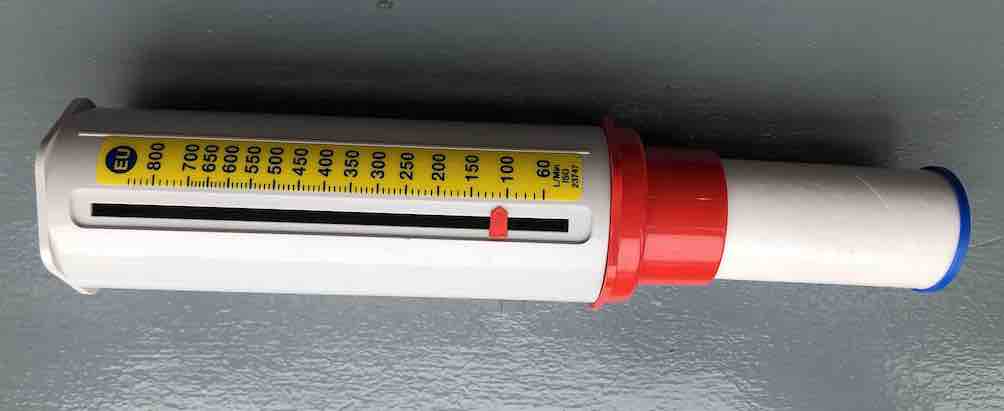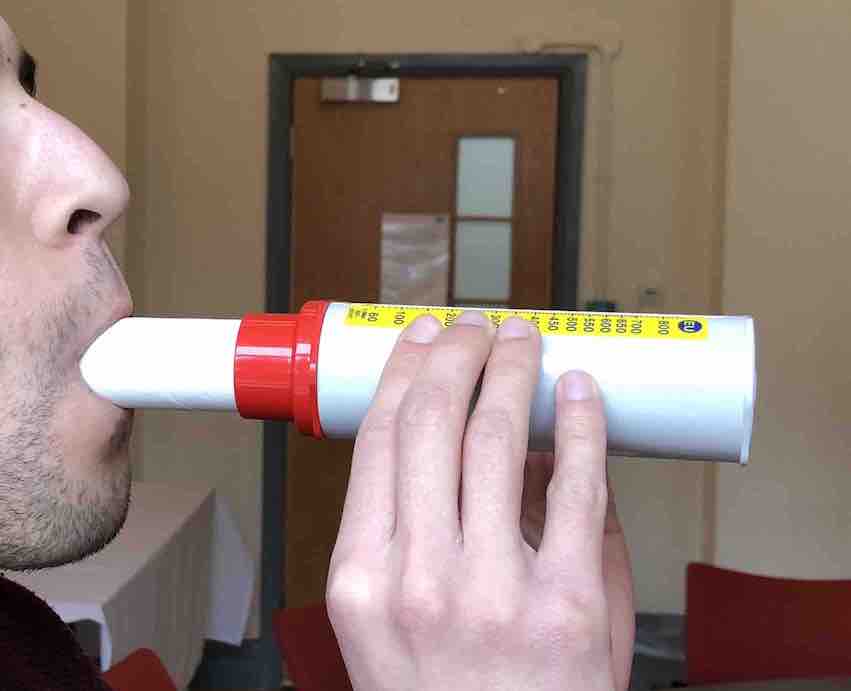Introduction
Introduce yourself with your name and role, and confirm the patient’s name and date of birth. Obtain consent and wash your hands.
History
Establish the patient’s understanding of their condition and why they need to use a peak flow meter. Then proceed to fill any gaps in their knowledge. This should be summarised using only a few sentences.
Purpose of a peak flow meter
Explain the purpose of a peak flow meter and peak expiratory flow rate (PEFR). PEFR is defined as the highest flow rate out of the mouth during a rapid forced expiration (i.e. a person’s maximum speed of expiration). This makes it ideal for monitoring obstructive diseases such as asthma. The greater the patency of the airway, the greater the rate of airflow. In an asthma attack, the PEFR can also be used to grade the severity of their attack.
Correct peak flow meter technique
Explain and demonstrate correct peak flow meter technique. There are various ways to approach this part. The ‘tell, show, do’ approach works well. This involves talking to the patient through the steps (listed below), moving to you demonstrating the correct technique to the patient and then finally asking the patient to perform the correct technique.
The correct technique will now be described below.
Preparing the peak flow meter
Obtain the peak flow meter and mouthpiece. The mouthpiece will fit onto the end of one side. Once again, ensure that you are sitting or standing upright. This is very important, as a deep breath will be required. The red dial should be set to zero every time that you use (breathe into) the device.

A peak flow meter with a mouthpiece inserted.
Using the peak flow meter
Keep hands on either side, being careful not to obstruct the red dial. Make sure that the peak flow meter is exactly horizontal, parallel to the floor. This is to avoid any confounding effects of gravity. Take in as deep a breath as possible, then secure a tight seal around the mouthpiece of the peak flow meter with your tongue below the mouthpiece, and breathe out as hard and as fast as possible. The red dial will move up from 0 to a value given on the side of the meter, giving the PEFR (measured in L/min). Reset and repeat three times, taking the best (highest) reading out of the three.

Ensure that the peak flow meter is horizontal.
Ending the demonstration
Once you have finished demonstrating and explaining, check for understanding and ask the patient to demonstrate the process back to you.
Peak flow diary
The best PEFR reading needs to be taken every day, once in the morning and once in the night. This value then needs to be recorded in a peak flow diary or something similar. This is required for the healthcare team to see the trend of the patient's asthma (getting better, worse, staying the same). The diary should be examined alongside the patient's medication use and the symptoms. In doing so, one can see if the patient has had any exacerbations of their asthma or any shortness of breath during a period when they have been exposed to a potential asthma trigger.

Normal values for PEFR. By Mikael Häggström, used with permission.
Conclusion
Summarise broadly what you have spoken about today with the patient, clarify if there is anything the patient does not understand and whether they have any further questions.
Wash your hands and remember to offer leaflets that provide more information about asthma, inhalers and peak flow at the end of the consultation.
Communication
The importance of communication in this station cannot be overstated. Examiners use it to differentiate good from exceptional candidates. A good candidate will be able to remember the necessary instructions, however a great candidate will be able to fluently communicate these in a simple, memorable way. Listed below are some of the most effective techniques:
Explicit categorisation
Organising the discussion into different categories to help structure the consultation. For example: “There are three things I’d like to discuss with you. Firstly I’d like to speak to you about what exactly asthma is, secondly, I will show you how to use the correct technique for your inhaler to help you breathe easier and finally I will explain how best to monitor your asthma using something we call a peak flow meter.”
Signposting
Transition statements can help you to move from one topic to another. For example: “We have talked and demonstrated how to use your inhaler correctly, now I’d like to show you how to use a peak flow meter to help us monitor how well controlled your asthma is.”
Avoid medical jargon
Ensure you use language that the patient will be able to understand. If you must use a medical term, be sure to explain what it means.